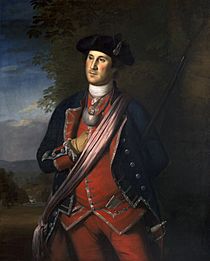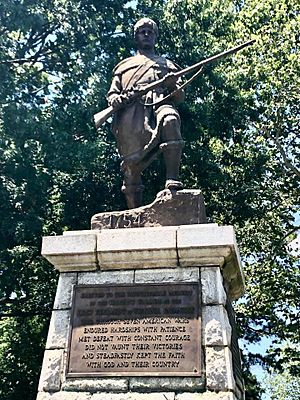Virginia Regiment facts for kids
Quick facts for kids Virginia Regiment |
|
|---|---|
|
George Washington (1772 portrait) wears a colonel's uniform of the Virginia Regiment.
|
|
| Active | 1754–1763 |
| Country | |
| Allegiance | |
| Type | Provincial troops |
| Role | Infantry |
| Engagements | French and Indian War |
| Commanders | |
| Commander | |
The Virginia Regiment was a special military group. It was created in 1754 by Virginia's Governor, Robert Dinwiddie. This group was a "provincial corps," meaning it was a local army for the Colony of Virginia.
The regiment played a big part in the French and Indian War. Its soldiers fought in important battles. These included Jumonville Glen and Fort Necessity in 1754. They also joined the Braddock Expedition in 1755. Later, they were part of the Forbes Expedition in 1758. Small groups from the regiment also fought in many smaller battles. These happened along Virginia's wild frontier.
Contents
History of the Virginia Regiment
The Virginia Regiment was formed because of a fight over land. This land was called the Ohio Country. In 1754, Virginia's government decided to create a regiment. It would have 300 men. Their mission was to go to where the Alleghany and Monongahela rivers meet.
After the Battle of Fort Necessity, the government made the regiment bigger. It grew from five companies to ten. In 1755, some Virginia troops joined the Braddock Expedition. They were defeated at the Battle of the Monongahela. These troops were not part of the main regiment at that time. They were organized into special groups.
Reforming the Regiment
After Braddock's defeat, the Virginia Regiment was quickly rebuilt. In 1755, the government voted to make it even larger. It grew to 1,500 men in 16 companies. By 1756, it had about 1,400 soldiers. In 1757, its size was reduced to 1,000 men.
In 1758, Virginia created two more regiments. Each had a thousand men. These new groups joined the Forbes Expedition. The first regiment's service ended in May 1759. The second one finished in December 1758. After Fort Duquesne was captured, the government decided to keep one regiment active. They also raised 500 more men for defense. This regiment stayed in service until May 1760.
Later Years and Disbandment
When the Anglo-Cherokee War started, the regiment's service was extended. They added 300 men as frontier guards. These soldiers stayed on the Cherokee frontier until early 1762. Then, the governor disbanded the regiment.
Later in 1762, the British government wanted Virginia to raise a new regiment. This new group would become part of the regular British army. Instead, Virginia's government voted to bring back the Virginia Regiment. This re-formed regiment was finally disbanded in May 1763. This happened just before Pontiac's War began. Virginia could not afford to keep the regiment going. They did not have enough paper money. The British government had stopped them from printing more.
Recruiting Soldiers
Most of the soldiers who joined were poor. George Washington described them as "loose, Idle Persons." He said they had "quite destitute of House, and Home." It was hard to find new soldiers. Many soldiers left because of bad supplies and very low pay. The work was also dangerous.
Recruiters for the Virginia Regiment even went to Pennsylvania and Maryland to find men. Washington noted that many recruits "have Scarce a Coat, or Waistcoat, to their Backs." Later, only poor people were drafted. These were people who could not find someone else to serve for them. They also could not pay a £10 fee to avoid service.
White males between 16 and 50 were allowed to join. However, records show some soldiers were as young as 15 or as old as 60. There were also a few soldiers with some African and Native American heritage.
Legacy of the Regiment
The First Virginia Regiment is remembered with a statue. It is in Meadow Park in Richmond, Virginia. The sculptor was Ferruccio Legnaioli. The statue was put up on May 1, 1930. It honors the regiment for fighting in seven American wars. This includes the Civil War, where they served in the Confederate Army.
The statue is a seven-foot-tall bronze figure. It shows a colonial soldier standing. The base of the statue lists the regiment's founding year, 1754. The pedestal is eight feet tall. It has bronze plaques that tell the regiment's history. They describe its service through seven wars. The statue was removed from its pedestal during the night of June 19–20, 2020.
Commanders of the Regiment
- 1754: Colonel Joshua Fry
- 1754-1757: Colonel George Washington
- 1758: First Virginia Regiment, Colonel George Washington; Second Virginia Regiment, Colonel William Byrd III
- 1759-1762: Colonel William Byrd III
- 1762-1763: Colonel Adam Stephen
Uniforms
The Virginia Regiment wore different uniforms over time. Here's what they looked like:
| Period | Regimentals | Buttons | Facings | Waistcoat |
|---|---|---|---|---|
| 1754–1755 | Red | Silver | Red | Red |
| 1755–1763 | Blue | Silver | Red | Red |
Successor Units
- When the Colony of Virginia created many regiments in 1775, these were called the Virginia Line. This happened when the American Revolutionary War began.
- The West Virginia Army National Guard's 201st Field Artillery Regiment can trace its history back to the Virginia Regiment.
- The 1st Virginia Regiment of the Virginia Defense Force is seen as the modern-day successor to the original Virginia Regiment.



